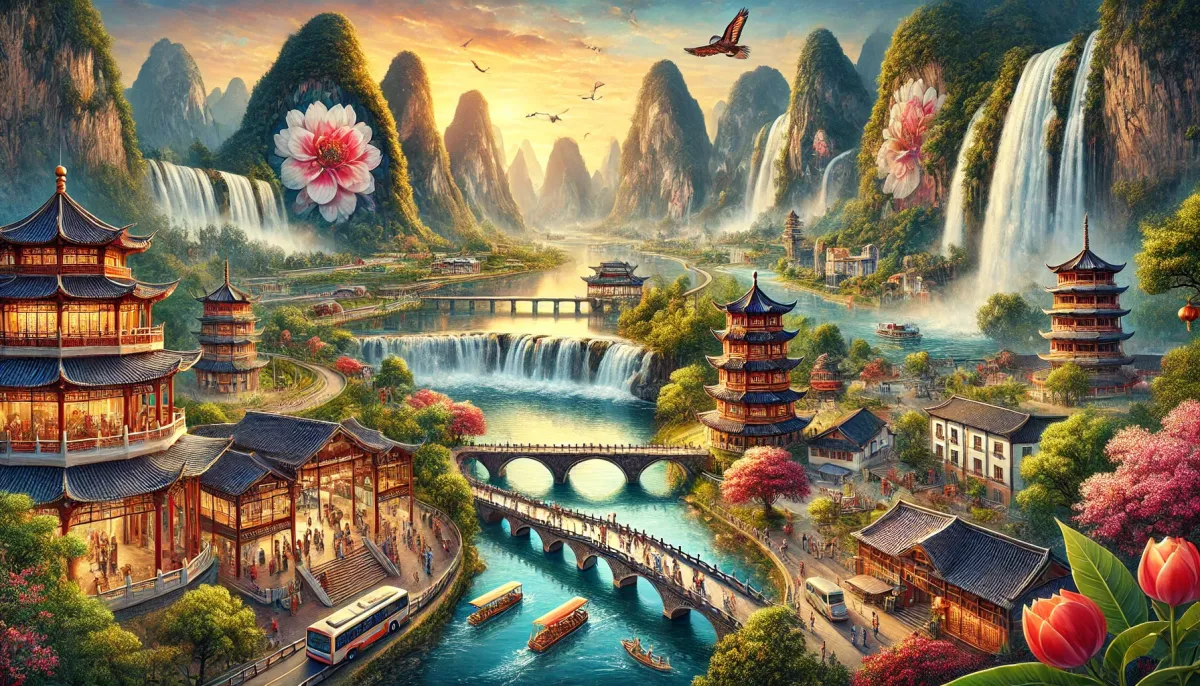Hi everyone, Mark here, your friendly neighborhood American backpacker. I've been exploring Asia for years, and recently, I had the incredible opportunity to delve into the vibrant culture and stunning landscapes of Guangxi, China. Get ready to ditch the usual tourist traps and discover a side of Asia that's both modern and deeply rooted in tradition.
Guangxi: Where Modernity Meets Ancient Charm
Guangxi is a captivating blend of modern infrastructure and rich ethnic traditions. While its cities boast a sophisticated, contemporary vibe, the province's heart throbs with the pulse of its indigenous peoples, particularly the Zhuang, China's largest ethnic minority group. This region has experienced a massive surge in tourism in recent years, moving beyond the well-known beauty of Guilin to reveal numerous hidden gems waiting to be discovered.
The Breathtaking Flower Mountain Paintings
One of the most significant discoveries during my trip was the Flower Mountain Paintings (花山壁畫) on the Ming River. These aren't your typical European-style paintings; instead, they're colossal murals etched onto sheer cliffs, a testament to the ingenuity and artistry of the ancient Zhuang people. Imagine the effort involved in reaching and painting these towering works of art on these near-vertical rock faces! They depict scenes from daily life, providing a unique glimpse into their history and culture.
These paintings are located in the Zhuang Autonomous Region of Guangxi, covering nearly 24 square kilometers of land, a region home to 19 million Zhuang people. It's truly awe-inspiring!
| Fact | Detail |
|---|---|
| Zhuang Population | 19 million (largest ethnic minority in China) |
| Flower Mountain Painting Location | Ming River, Guangxi Zhuang Autonomous Region |
| Significance | UNESCO World Heritage Site candidate |
| Painting Style | Unique to the region, depicting daily life |
A Journey Through the Zhuang Culture
The landscape itself is breathtaking, with karst formations that dot the hills, showcasing the unique Zhuang flair at almost every turn. The Flower Mountain Paintings, a powerful contender for UNESCO World Heritage status, perfectly encapsulate this unique culture and its fascinating history.
Guangxi shares a 1000km border with Vietnam, leading to a dynamic cross-border tourism industry. The many border crossings not only facilitate frequent trade but also enhance the tourism potential of this already captivating region.
Mingxi Countryside: A Serene Escape
Before reaching the Flower Mountain Paintings, I visited the Panlong Mountain caves and the Bat Mountain murals – just a delightful appetizer before the main course! The journey itself is stunning; hidden among the hills are over 100 of these paintings. I was particularly struck by one gigantic mural – 125 meters wide and 44 meters tall! Figures range from 30 centimeters to 5 meters in size, depicted riding strange creatures that are neither horse nor dog. These seemingly pyramid-like cliffs, sliced vertically by what appears to be a giant knife, reveal vibrant crimson traces of the ancient art. The paintings' age is unknown, but pigment analysis suggests a Zhuang origin around 2400 years ago. The subject matter remains a mystery, adding to their enigmatic allure.
Ming Shi Tian Yuan: A Picturesque Retreat
My journey continued to Ming Shi Tian Yuan (明仕田园), a smaller yet remarkably popular scenic area near Xingcheng County, Guangxi. This area showcases the breathtaking beauty of the Ming Shi River, a tributary of the Pearl River, originating in Vietnam and winding for roughly 8 kilometers (only about 2.2 kilometers of which are currently developed).
I took a relaxing bamboo raft ride down this emerald river. The sun shone brightly, the air was fresh, and the scenery was idyllic. This tranquil beauty contrasts sharply with the grandeur of Guilin's landscapes – offering a more intimate and charming rural experience. Its serene beauty has attracted numerous film and television crews, and it's become a popular destination for wedding photoshoots.
| Location | Description |
|---|---|
| Ming Shi Tian Yuan | Picturesque rural area with scenic river; popular film location |
| River | Ming Shi River (originating in Vietnam) |
| Atmosphere | Tranquil, intimate, perfect for relaxation |
Detian Waterfall: A Cross-Border Spectacle
My next adventure took me to Detian Waterfall (德天瀑布), a truly unique experience. This magnificent waterfall straddles the border between China and Vietnam, offering a truly unforgettable cross-cultural immersion. It's 120 meters wide and boasts three levels, cascading down over 60 meters.
| Waterfall Feature | Description |
|---|---|
| Width | 120 meters (China side); 208 meters (combined with Ban Gioc) |
| Height | Over 60 meters |
| River Source | Gui Chun River |
| Best Visiting Time | July - November (rainy season) |
| Significance | 4th largest cross-border waterfall globally; Asia's largest |
Youyi Pass: A Journey Through History
Finally, I concluded my Guangxi adventure at Youyi Pass (友誼關), located in Pingxiang City. This is one of China's nine famous passes, and it served as a major land route to Vietnam for centuries. Its history dates back to the Han Dynasty, with several name changes reflecting the evolving political landscape. The name "Youyi" (Friendship) reflects the hopeful sentiment of peaceful relations between the two countries, even as the history of the region is punctuated by conflict. It's also a great place to see the national flags of both countries proudly displayed by residents. The pass offers a compelling glimpse into the complex history of Sino-Vietnamese relations.







